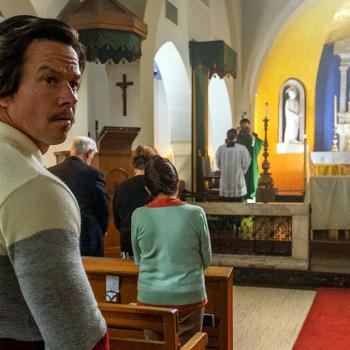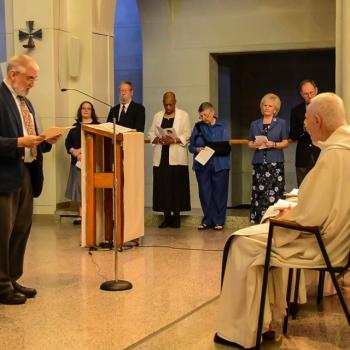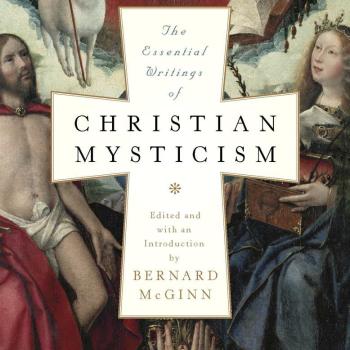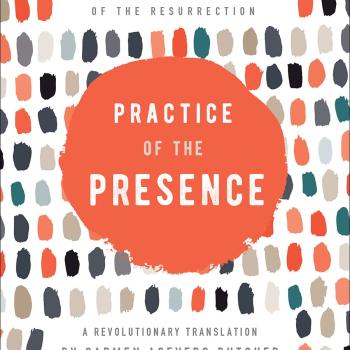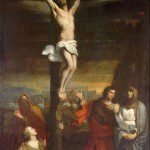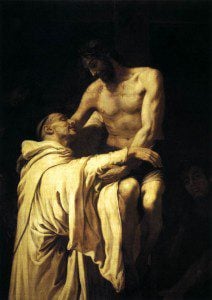
2015 is something of a red-letter year for Christian contemplatives.
This is the 100th anniversary of the birth year of Thomas Merton, who was born on January 31, 1915. Merton lived until 1968, and in his short life wrote over fifty books, published both before and after his accidental death at age 53. Merton entered the Trappist Abbey of Gethsemani in 1941, and became world-renowned after his spiritual memoir, The Seven Storey Mountain, became a surprise bestseller in 1948. Merton is a textbook example of why you don’t write your autobiography while in your 30s — he eventually grew to rue the book’s youthful swagger and arrogance. But even with its flaws, Seven Storey is a compelling and beautifully written book, and it gave Merton a lifelong platform for his own continual spiritual evolution — from a rather ordinary writer of prosaic books of Catholic piety in the late 40s and early 50s, to an outspoken critic of social/national sins such as racism and the nuclear arms race, and an eager proponent of interfaith dialogue, particularly with Buddhism. Among Merton’s most lasting spiritual writings are New Seeds of Contemplation and The Inner Experience. As a mystic, Merton is noted for three “epiphanies” of moments of profound spiritual insight: in a Catholic Church in Cuba in 1940, he embodied heaven-on-earth during the Mass; at a busy street corner in Louisville, KY, in 1958, he “fell in love with all those people” and saw that our common humanity mattered more than artificial religious or vocational distinctions; and in 1968, just days before he died, while visiting the ancient city of Polonnaruwa in Ceylon (now Sri Lanka) and gazing upon the magnificent stone carved Buddhas in the Gil Vihara monastery, he sensed “beauty and spiritual validity running together in one aesthetic illumination” that he compared to sunyata or “emptiness”: “everything is emptiness and everything is compassion.” It was a luminous instance of unity in which the Catholic monk encountered spiritual truth in a Buddhist setting: truly a moment of grace.
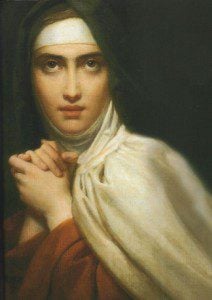
2015 also marks the 500th anniversary of the birth year of Saint Teresa of Ávila, born on March 28, 1515. Teresa Sánchez de Cepeda y Ahumada entered a Carmelite convent as a young woman, and despite ill health went on to become not only a great mystic and contemplative, but also the spearhead of the Discalced Carmelite reform, which began in Spain in 1562 with the founding of the Convent of St. Joseph, where Teresa along with several other nuns sought to follow a more rigorously contemplative religious life in the spirit of the earliest Carmelites. While the reform met with much opposition in Teresa’s lifetime, she — along with her protege, Saint John of the Cross — managed to establish fourteen new convents, thus setting the stage for the formal establish of the Discalced Carmelites in 1593. As a woman with a vibrant prayer life and a vivid relationship with Christ as both her king and her lover, Teresa was often misunderstood by her confessors or other spiritual mentors. In the 1560s one of her confessors instructed her to write an account of her life; the result, The Book of My Life, is a classic spiritual autobiography on a par with Augustine’s Confessions or Merton’s Seven Storey Mountain. Numerous other writings followed, including two renowned masterpieces of mystical literature: The Way of Perfection, written for the Carmelites as a manual of prayer, and Interior Castle, a brilliant depiction of the stages of mystical faith, comparing the developmental spiritual life to a castle where Christ presides as lord in the center, and various “mansions” or rooms represent different dimensions of prayer and sanctification as a soul seeks union with the Divine lover. Not only has Teresa been canonized as a saint, she is one of only four women to be declared a “Doctor of the Church,” meaning her writings are considered exemplary teachings of the Catholic faith.
2015 is likewise the 500th anniversary of the birth year of Saint Philip Neri, born on July 21, 1515. Neri was not a writer and so may not enjoy the same renown as Merton or Teresa, but he is remembered as the founder of a religious order, the Congregation of the Oratory, and especially as a proponent of a cheerful, even playful spirituality — certainly not the norm in the sixteenth century! “A joyful heart is more easily made perfect than a downcast one,” he said, revealing a positive piety that made him a favorite among the poor. He was canonized a saint in 1622.
And finally, 2015 is the 900th anniversary of the founding of the Cistercian Monastery of Clairvaux, France, traditionally said to have been established on June 25, 1115. Clairvaux matters because its first abbot, Bernard, is — while not as well known today as Merton or Teresa — one of the most important figures in the entire history of western Christian mysticism. Saint Bernard of Clairvaux wrote prolifically, including a classic treatise On Loving God and a sublime set of mystical Sermons On the Song of Songs, and was the first important voice in the tradition to articulate the relationship between the individual and God in terms of passionate love. St. Bernard was a key figure in the development of medieval devotion to Mary, helped to establish Saint Hildegard of Bingen’s reputation as a mystic and visionary, and mentored pope Eugene III. St. Bernard was deeply involved in both church and secular politics — his reputation is marred because of his support for the second crusade — but his lasting legacy must be his spirituality, encoded in writing which is eloquent, luminous, and at times bitingly funny. Under Saint Bernard’s guidance the Cistercian order was transformed from a single struggling monastery to a mighty confederation of over 300 monasteries and priories at the time of his death in 1153. Saint Bernard was canonized in 1174 and declared a Doctor of the Church in 1830.
So enjoy 2015 — and think of the amazing contemplatives and mystics who were born (or began their careers) in 1915, 1515, or 1115. I wonder who will be born this year to make a signfiicant difference for the church of the future?
Please note that if you follow one of these links it will take you to Amazon, where if you make a purchase, the author of this blog receives a small commission. Thank you for doing so — it’s the easiest way you can support the ministry of this blog.
Enjoy reading this blog?
Click here to become a patron.






